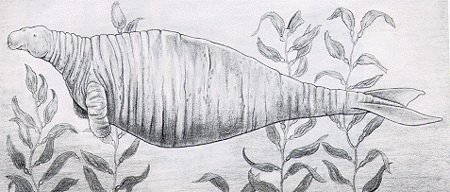|
| Query: Steller's sea cow | Result: 1st of 9 | |
Steller's Sea Cow (Hydrodamalis gigas) - Wiki
| Subject: | Steller's Sea Cow (Hydrodamalis gigas) - Wiki
| | Poster: | Administrator (kusnij@naver.com)
| |

| Resolution: 450x192
File Size: 49401 Bytes
Date: 2008:04:08 09:15:54
Upload Date: 2008:04:08 09:17:31
|
Steller's Sea Cow
From Wikipedia, the free encyclopedia
Order: Sirenia
Family: Dugongidae
Subfamily: Hydrodamalinae Palmer, 1895
Genus: Hydrodamalis
Status: Extinct (1768)
[Photo] Drawing of a Stellar's Sea Cow circa mid 18th century. Source: http://en.wikipedia.org/wiki/Image:Hydrodamalis_gigas_drawing.png
Steller's sea cow (Hydrodamalis gigas) is an extinct, large sirenian mammal formerly found near the Asiatic coast of the Bering Sea. It was discovered in the Commander Islands in 1741 by the German naturalist Georg Steller, who was traveling with the explorer Vitus Bering. A small population lived in the arctic waters around Bering Island and nearby Copper Island. However, prior to the arrival of humans they lived all along the North Pacific coast.
Description
The sea cow grew up to 7.9 meters (25.9 ft) long and weighed up to three tons, much larger than the manatee or dugong. Steller's work contains two contradictory weights: 4 and 24.3 tons. The true value may lie between these figures. It looked somewhat like a large seal, but had two stout forelimbs and a whale-like tail. According to Steller, "The animal never comes out on shore, but always lives in the water. Its skin is black and thick, like the bark of an old oak..., its head in proportion to the body is small..., it has no teeth, but only two flat white bones—one above, the other below". It was completely tame, according to Steller. They fed on a variety of kelp. Wherever sea cows had been feeding, heaps of stalks and roots of kelp were washed ashore. The sea cow was also a poor swimmer and is not believed to have been able to dive.
Population and extinction
The population of sea cows was small and limited in range when Steller first described them. Steller said they were numerous and found in herds, but in 1887, zoologist Leonhard Hess Stejneger estimated that at discovery there had been less than 1500 remaining and in they were thus in immediate danger of extinction from overhunting by humans. They were quickly wiped out by the sailors, seal hunters, and fur traders that followed Bering's route past the islands to Alaska, who hunted them both for food and for their skins, which were used to make boats. They were also hunted for their valuable subcutaneous fat, which was not only used for food (usually as a butter substitute), but also for oil lamps because it did not give off any smoke or odor and could be kept for a long time in warm weather without spoiling. By 1768, less than 30 years after it had been discovered, Steller's sea cow was extinct.
Fossils indicate that Steller's sea cow was formerly widespread along the North Pacific coast, reaching south to Japan and California. Given the rapidity with which its last population was eliminated, it is likely that the arrival of humans was the cause of its extinction over all of its original range.
A slightly alternative extinction theory has been promoted by Paul Anderson, who argues that the aboriginal peoples in the sea cow's range removed sea otters from the inland areas. With the otters gone, the population of sea urchins, which was kept down by the predatory otters, greatly increased and ate more algae, which was the Steller's Sea Cow's primary source of food. Therefore, the sea cow was limited to coastal areas of islands without a human population by the time Bering arrived and was already endangered.
Possible sightings
There are still sporadic reports of sea cow-like animals from the Bering area and Greenland, so it has been suggested that small populations of the animal may have survived to the present day. This remains so far unproven.
In literature
Sea cows appear in Rudyard Kipling's short story "The White Seal", where they show the title character a place of refuge from human hunters. Kipling probably knew (a) that the sea cow was considered extinct and that (b) nevertheless people sometimes claimed to have seen them. Thus, his suggestion is that they are around, but mostly hiding.
http://en.wikipedia.org/wiki/Steller's_Sea_Cow
| The text in this page is based on the copyrighted Wikipedia article shown in above URL. It is used under the GNU Free Documentation License. You may redistribute it, verbatim or modified, providing that you comply with the terms of the GFDL. |
|
Comments |
|---|
| | Guest |
|
| 스텔러바다소 (스텔라해우) Hydrodamalis gigas (Steller's Sea Cow; Great Northern Sea Cow) |
| | Guest |
|
Scientific Name: Hydrodamalis gigas (Zimmermann, 1780)
Common Names: Steller's Sea Cow, great northern sea cow |
^o^
Animal Pictures Archive for smart phones
^o^
|
|
|

